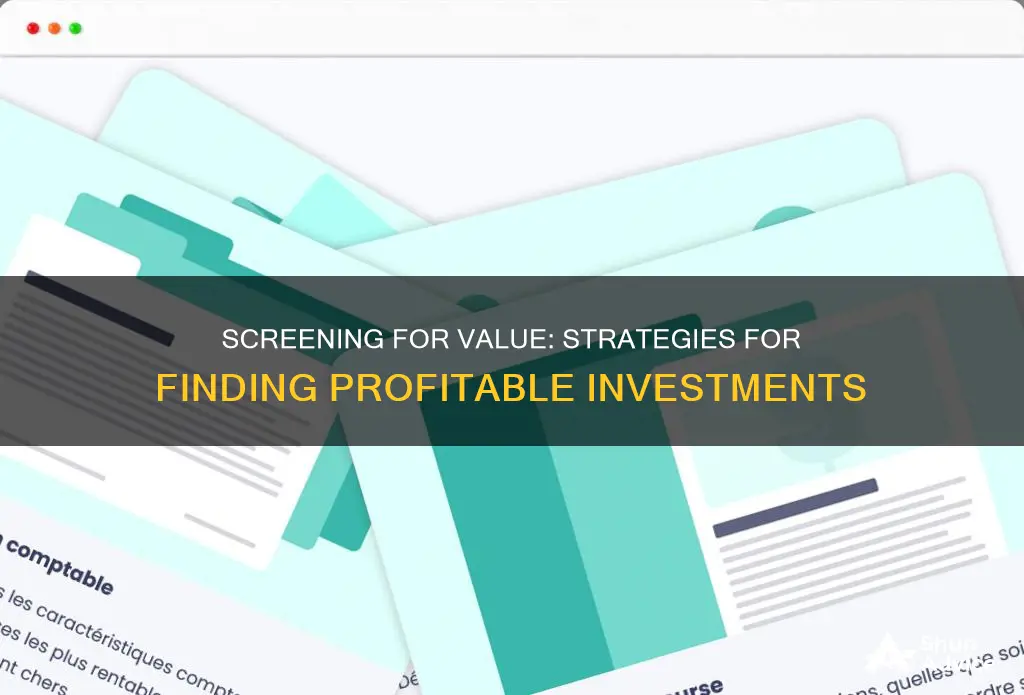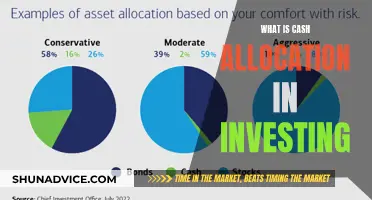
Stock screeners are powerful tools for investors to identify potential investment opportunities by filtering through thousands of stocks based on specific financial criteria. They help investors focus on stocks that align with their unique investment strategies, goals, and preferences. By using a combination of basic and advanced screeners, investors can narrow down their options to a more manageable group for further analysis. While stock screeners provide a quantitative analysis of stocks, investors should also conduct their own research and not solely rely on screener results to make investment decisions.
What You'll Learn

Understanding the basics of stock screeners
Stock screeners are powerful tools that help investors identify potential investment opportunities by filtering through thousands of stocks based on specific criteria. Here are some key points to understand about stock screeners:
- Functionality: Stock screeners allow you to input various parameters or criteria, such as market capitalisation, price-to-earnings (P/E) ratio, revenue growth, earnings per share (EPS) growth, and more. The screener then generates a list of stocks that meet your specified criteria.
- Ease of Use: Using a stock screener is quite straightforward. You answer a series of questions or input your search criteria, and the screener does the rest. It's important to note that the quality of results depends on the criteria you provide.
- Data Sources: Stock screeners rely on databases of companies and financial information. Ensure that the data is up-to-date and relevant, as some screeners may have different update schedules.
- Quantitative Analysis: Stock screeners focus on measurable factors that affect a stock's price, such as market capitalisation, revenue, volatility, profit margins, and performance ratios. They help users perform quantitative analysis by narrowing down the vast array of stocks to those that align with their investment strategy.
- Customisability: Many stock screeners offer both basic and advanced options. Basic screeners have predetermined sets of variables with values you can set as criteria. Advanced or premium screeners may offer more flexibility and additional features, such as charts, real-time quotes, and email alerts.
- Predefined Screens: Some screeners provide predefined screens or pre-set filters to help you get started. For example, Yahoo! Finance offers screens like "Undervalued Large Caps," "Day Gainers," and "Portfolio Anchors." These predefined screens can be useful if you're not sure what specific criteria to use.
- Limitations: Stock screeners primarily focus on quantitative factors and may not capture qualitative aspects, such as pending lawsuits, labour issues, or customer satisfaction. Additionally, they may have industry-specific blind spots, and it's important to cross-reference the results with your own research and analysis.
- Free vs. Paid: There are many free stock screeners available, such as those offered by Yahoo! Finance, Zacks, and FINVIZ. Paid or premium screeners often provide additional features, more up-to-date data, and enhanced customisation options.
By understanding the basics of stock screeners, you can utilise them effectively to narrow down investment options and make more informed decisions. Remember to use stock screeners as a starting point and combine their results with your own research for a comprehensive investment strategy.
Physical Cash Investment: Strategies for Smart Money Allocation
You may want to see also

Knowing what to screen for
Screeners are extremely flexible but only if you know what you're looking for. To help investors, some sites have predefined stock screens with variables already entered.
For example, Yahoo! Finance includes several predetermined screens, including Undervalued Large Caps, Day Gainers, and Portfolio Anchors. The search criteria of each predetermined screen are clearly explained so that users can understand the underlying principles.
MSN Money includes a series of popular screens that can be further filtered and sorted by category.
Finviz includes a signal drop-down menu that filters for criteria such as top gainers, recent insider buying, and wedges.
When deciding what to screen for, it's important to keep in mind that most stock screeners only include quantitative factors. There are still many qualitative factors that are important to consider. No screener provides information about things like pending lawsuits, labour problems, or customer satisfaction levels.
- Return on Equity > 15% indicates high profitability and a potential competitive advantage
- A Debt-to-Equity ratio of <0.5 implies that the company does not heavily depend on outside capital to finance its growth
- A Current Ratio > 2 makes sure that the company is able to pay its short-term obligations
- A Price-to-Earnings ratio (P/E) that is acceptable to you
- A particular industry or market capitalization that you are interested in
Investing vs. Saving: Where Should Your Cash Go?
You may want to see also

Interpreting screener results
Interpreting the results of a stock screener is a crucial step in the investment process. Here are some key considerations:
- Understand the metrics: Familiarise yourself with the metrics used in the screening process, such as price-to-earnings ratio (P/E), earnings per share (EPS), return on equity (ROE), and dividend yield. Know how these metrics relate to your investment strategy. For example, value investors typically look for stocks with low P/E ratios and high dividend yields.
- Compare and contrast: Look for patterns or trends in the screener results. Identify sectors or industries that consistently appear in the list, as this can provide insights into market trends and potential investment opportunities. Compare the metrics of individual stocks within the same sector to find the most attractive investments.
- Consider multiple perspectives: Different investors have different strategies and goals, so consider various perspectives to gain a well-rounded understanding of the stocks' investment potential. For example, growth investors might focus on stocks with high EPS growth rates, while income investors might prioritise stable dividends.
- Dig deeper with fundamental analysis: While screeners are a great starting point, it's important to perform fundamental analysis on the stocks that meet your criteria. Evaluate the company's financial statements, management team, competitive position, and market conditions. This will help you assess the intrinsic value of the stock and its long-term growth potential.
- Utilise technical analysis: In addition to fundamental analysis, consider using technical analysis techniques to evaluate stock price patterns, volume trends, and other market indicators to predict future price movements and identify potential entry and exit points for your investments.
- Seek expert opinions: Consult with financial advisors or seek expert opinions to gain valuable insights, identify potential risks, and consider alternative perspectives. Remember to do your own due diligence before making investment decisions.
By interpreting the screener results effectively, you can make more informed investment decisions that align with your strategy and goals.
Example: Interpreting screener results for value investing
When using a stock screener for value investing, here are some key metrics and considerations:
- Price-to-Earnings Ratio (P/E): A low P/E ratio suggests that a stock is undervalued and may be an attractive investment opportunity for value investors.
- Price-to-Book Ratio (P/B): A low P/B ratio indicates that a stock may be trading below its intrinsic value, making it appealing for value investors, especially in industries with substantial tangible assets like manufacturing or real estate.
- Dividend Yield: Income-focused value investors should look for stocks with high dividend yields, but also assess the sustainability of dividend payments.
- Debt-to-Equity Ratio: Value investors typically prefer companies with lower debt levels, as they are considered more financially stable.
- Return on Equity (ROE): Value investors often seek companies with consistently high ROE, as it demonstrates the company's ability to generate returns for shareholders.
Streamline your search by using a stock screener to automate the process and quickly identify stocks that meet your specific criteria, such as market capitalisation or price-to-earnings ratio. Compare different stocks side by side to evaluate their fundamentals and determine if they are undervalued relative to their peers.
Remember to complement the use of a stock screener with qualitative analysis to gain a comprehensive understanding of a company's value and growth potential.
Outside Investment: Blessing or Cash Flow Curse?
You may want to see also

Using screeners with other tools
Screeners are extremely useful for narrowing down a list of stocks to research further, but they should not be the only tool you use. Here are some other tools and strategies you can use in conjunction with screeners to find value investments:
- Customizable screeners: Some screeners allow you to input your own specific criteria, such as market capitalization, price/earnings ratio, and return on equity. This can help you tailor your search to your unique investment goals and preferences.
- Predefined screens: Some websites offer predefined screens with set criteria. For example, Yahoo! Finance offers screens such as "Undervalued Large Caps", "Day Gainers", and "Portfolio Anchors". These can be useful if you are unsure what criteria to use or want to explore different investment strategies.
- Fundamental analysis: In addition to using screeners, it is important to review the major financial statements of the companies you are considering investing in, including the income statement, balance sheet, and cash flow statement. Look for indicators such as inventory growth, accounts receivable growth, and tangible liquid assets.
- Technical analysis: While technical analysis should not be the main factor in your stock selection process, it can be useful to consider a company's stock price trajectory and volume. Look for stocks that are advancing in price on higher volume, as this indicates accumulation and broad-based momentum.
- News and market data: Staying up-to-date on economic, industry, and company-specific news can help you make informed investment decisions. Follow business reports on television and online, track investor sentiment on social media, and keep an eye on interest rates, the energy sector, and other economic indicators.
- Comparative analysis: Use screeners to compare your preferred stocks to their competition. Look for undervalued opportunities relative to peers to gain an edge in the market.
- Global accessibility: Online screeners give you access to market information and investment opportunities from anywhere in the world. Take advantage of this to stay up-to-date on global stock market developments.
- Broker integration: Some screeners offer broker integration, allowing you to connect your broker account and access additional features such as profit and loss reporting and portfolio rebalancing recommendations.
Understanding Dividends: Cash Dividends and Their Nature
You may want to see also

The limitations of stock screeners
Stock screeners are powerful tools that allow investors to filter and analyze stocks based on specific criteria, streamlining the process of identifying investment opportunities. However, they have some limitations that users should be aware of. Here are some of the limitations of stock screeners:
Quantitative Comparison Only
Most stock screeners primarily focus on quantitative parameters as the criteria for selecting stocks. While these tangible variables such as market capitalization, revenue, volatility, and profit margins are important, there are also many qualitative factors that should be considered. These may include customer satisfaction, pending lawsuits, labor problems, business operations, and corporate governance, among others. These qualitative aspects can significantly impact a company's performance and should not be overlooked.
Timeliness of Data
Stock screeners rely on databases that update on different schedules. It is important for users to always check the relevance and timeliness of the data provided by the screener. Outdated information can lead to inaccurate analysis and decision-making. Therefore, users should verify the freshness of the data before relying solely on the screener's output.
Industry-Specific Blind Spots
Stock screeners may have industry-specific blind spots that can affect the results. For example, when searching for low price-to-earnings (P/E) valuations, users may not see many tech companies in the results. This is because tech companies often have high P/E ratios due to their high growth potential. Therefore, it is important to be aware of the limitations and biases that may be present in the screener's algorithm.
Need for Specific Criteria
With the vast number of stocks available on stock screeners, users must input specific search criteria to narrow down the options. Entering only a few criteria may result in an overwhelming number of search results, making it challenging to make informed decisions. Therefore, it is essential to have a clear understanding of the desired investment profile and to input corresponding specific criteria to obtain meaningful results.
Potential Bias
Different stock screeners may produce different listings of stocks for the same criteria due to potential programmer bias. For example, a stock screener may be designed to favor certain stocks or industries, influencing the ranking or weighting of specific companies in the results. Users should be aware of these potential biases and validate the results through independent research.
Limitations of Free Versions
While free stock screeners are widely available, they may come with certain limitations. These can include advertisements, limited features, or restricted access to advanced criteria and parameters. To access the full capabilities of a stock screener, users may need to opt for premium or subscription-based versions, which offer enhanced data analysis, real-time quotes, email alerts, and other benefits.
In conclusion, while stock screeners are valuable tools for investors, they have certain limitations. Users should be mindful of these limitations and complement the screener results with their own research and analysis. Stock screeners should be used as a starting point, and investors should conduct further due diligence before making investment decisions.
Investment Cash Flow: Essential for Business Growth and Stability
You may want to see also
Frequently asked questions
Some good free screeners to find value investments include Yahoo Finance, Zacks, and Finviz. There are also paid screeners with more features, such as GuruFocus, Stock Rover, and Value Scout.
Some basic parameters to identify undervalued stocks are:
- Return on Equity > 15%
- Debt-to-Equity ratio < 0.5
- Current ratio > 2
Some characteristics of successful companies include accelerated sales and earnings growth of over 15%, high levels of insider buying, and solid charts with steady price advancement on higher volume.
In general, it is recommended to avoid distributors or commodity-type businesses, companies with gross margins below 20%, companies that are not considered "best in class", thinly traded companies, and companies that have recently announced a large acquisition.
It is important to review the income statement, balance sheet, and cash flow statement. Look for inventory growth in proximity to revenue growth, accounts receivable growth relative to sales growth, and tangible liquid assets.







